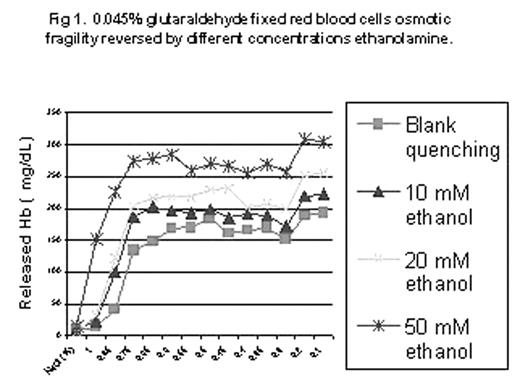Abstract
It has much more advantages to preserve human red blood cells (RBC) in freezing and drying form than conventional blood storage, even though it is still under developing. In the present study, we successfully used 0.045% glutaraldehyde(GA) to fix RBCs under appropriate conditions prior to lyophilization and regained the bulk of RBCs membrane filterability. The phlebotomized whole blood was anti-coagulated with CPDA-1 and the plasma was removed by centrifugation. White blood cells were removed using Leucocytes filter (Pall Corporation). 1 x 10 9 cells/ml were separately incubated with 0.03%, 0.045% and 0.05% GA at 37 °C for 10 min; RBCs at concentrations 0.5 x 10 9, 1 x 10 9 and 2 x 10 9 cell/ml were incubated with 0.045% GA at 37 °C for 10 min; Bovine serum albumin (BSA), trehalose, hydroxyethyl starch and dextran were used as protective additive in freezing and drying RBCs, respectively; ethanolamine, glycine, lysine, BSA, glutamic acid and homocysteic acid were used to recover membrane deformability due to GA fixation. Recovery RBCs yield after reconstituion was determined by a cell counter. Fee hemoglobin , glutathione (GSH), 2,3-diphosphoglycerate (2,3-DPG), ATP, and Glucose-6-phosphate dehydrogenase (G-6-PDH) in RBCs were determined before and after lyophilization. Membrane flexibility was assayed by osmotic fragility test. RBCs filterability was determined using positive filter apparatus through 5 micrometer pore size nitrocellulose membrane. Our results suggested that RBCs at 1 x 10 9 cells/ml fixed by 0.045% GA for10 min at pH 7.8 were enough to resist freezing and drying damages and the bulk of RBCs’s membrane filterability were remained. The effective fixation of GA is dependent on GA’s concentration, RBCs concentration, incubation period and pH etc. BSA is the most potential additive in preserving RBCs. More interestingly, the following reagents can recover the reduced RBCs membrane filterability by GA fixation. The potency of recovery is in the order of : 10 mM ethanolamine > 5 mM lysine > 0.5%BSA > 10 mM glutamatic acid > 5 mM homcysteic acid > 2% glycine. After reconstitution, 85 ± 2.3% RBCs yield is achieved, 71 ± 4.1% of these RBCs can freely pass through 5 micrometer pore size filter membrane. Biochemical function indexes as GSH, 2,3-DPG, ATP, and G-6-PDH are saved by 20 ± 1.2%.
Lyophilized human red blood cells yields from reconstitution by different treatment.
| 1x 109 cells/ml fixed at . | . |
|---|---|
| 0.03% glutaraldehyde | 44.7 ± 4.1 |
| 0.045%glutaraldehyde | 84.7 ± 5.8 |
| 0.05%glutaraldehyde | 88.7 ± 7.6 |
| 0.045% glutaraldehyde fix: | |
| 0.5x 109 cells/ml | 91 ± 4.3 |
| 1x 109 cells/ml | 84.7 ± 5.8 |
| 2 x 109 cells/ml | 35.2 ± 2.3 |
| 1x 109 cells/ml fixed at . | . |
|---|---|
| 0.03% glutaraldehyde | 44.7 ± 4.1 |
| 0.045%glutaraldehyde | 84.7 ± 5.8 |
| 0.05%glutaraldehyde | 88.7 ± 7.6 |
| 0.045% glutaraldehyde fix: | |
| 0.5x 109 cells/ml | 91 ± 4.3 |
| 1x 109 cells/ml | 84.7 ± 5.8 |
| 2 x 109 cells/ml | 35.2 ± 2.3 |
Effects of various treatment on lyophilized RBCs after reconstitution.
| Group . | Filterability(%) . |
|---|---|
| 1x9 cells/ml fixed by: . | . |
| N = 5. | |
| 0.03%glutaraldehyde | 88.3 ± 1.2 |
| 0.045%glutaraldehyde | 73.3 ± 1.8 |
| 0.05%glutaraldehyde | 44.7 ± 2.8 |
| 0.045%glutaraldehyde fixation at: | |
| 0.5x109 cells/ml | 0 |
| 1x109 cells/ml | 73.3 ± 1.8 |
| 2x109 cells/ml | 83.9 ± 4.6 |
| Group . | Filterability(%) . |
|---|---|
| 1x9 cells/ml fixed by: . | . |
| N = 5. | |
| 0.03%glutaraldehyde | 88.3 ± 1.2 |
| 0.045%glutaraldehyde | 73.3 ± 1.8 |
| 0.05%glutaraldehyde | 44.7 ± 2.8 |
| 0.045%glutaraldehyde fixation at: | |
| 0.5x109 cells/ml | 0 |
| 1x109 cells/ml | 73.3 ± 1.8 |
| 2x109 cells/ml | 83.9 ± 4.6 |
Author notes
Corresponding author


